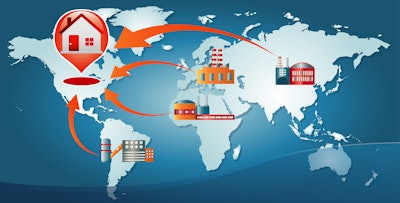
The U.S. business logistics costs (USBLC) in 2021 were elevated by 22.4% to $1.85 trillion, representing 8% of 2021’s $23 trillion GDP, according to the 2022 State of Logistics Report, produced for the Council of Supply Chain Management Professionals (CSCMP) by Kearney and presented by Penske Logistics.
“This year’s State of Logistics’ report is simply an outstanding and valuable asset to any supply chain organization. Competing in today’s global marketplace is not just about the high-quality products supply chains plan, procure, make and deliver. It’s also about impacting the global community and doing vital work like making and delivering life-saving vaccines. In the 33rd year of this remarkable report, our readers will not only be in the best position to benchmark their own supply chain progress but to refine their approach, leading to better results. With supply chain making up the clear majority of most company’s operations and that of its workforce, it has the greatest potential to make a real impact on its competitive advantage. I wish to thank our collaborative research and author partner Kearney, IHS Market, Penske Logistics and the CSCMP staff for all of their contributions,” says Mark Baxa, CSCMP president and CEO.
“It’s not surprising that we are continuing to see ongoing disruptions related to the pandemic, but the scope and impact of disruptions continue to weigh heavily on the minds of logistics providers, as they do for all companies contributing to the U.S. economy. What is notable for 2021, however, is that the logistics sector has begun to enable changes which should benefit manufacturers, retailers and consumers alike. We’re especially heartened by the progress the sector has made in rebuilding supply chain resilience via multi-shoring, automation and optionality in last-mile distribution. This will also improve customer service and bring efficiencies for all parties,” says Balika Sonthalia, partner at Kearney and lead author of the report.
From PR Newswire:
- Business inventories dropped to near historic lows, but the costs associated with storing, handling and financing these items rose considerably.
- Inventory-carrying costs rose by 25.9% in 2021, and transportation costs jumped 21.7%. This led to uneven supply chains and inconsistent product availability for consumers (both in-person and online).
- Efforts to increase multi-shoring are expected to accelerate. Companies are seeking to have operations move closer to the United States to respond quicker to fluctuating market demands.
- Last year’s report noted the effects of the pandemic on the supply chain. The residual challenges of the pandemic remain, with some disruptions continuing to deliver damaging effects on capacity.
- Last-mile delivery volume is trending upward. The 2022 report notes that e-commerce sales grew 10% last year (to $871 billion), accounting for 14% of U.S. retail sales.
- Trucking freight continues to see more volume and opportunities. With road freight accounting for the largest segment of the U.S. supply chain spend, it expanded by 23.4%, to a lofty $831 billion spend.
“We have seen an incredible amount of resiliency among private truck fleets and dedicated contract carriage truck fleets. Demand has been up sharply year-over-year and these fleets continue to manage the complexities they face in the trucking supply chain including headwinds caused by shortages of parts, equipment, drivers, and most recently rising fuel costs. The State of Logistics Report does an excellent job of accurately capturing these challenges across all modes of transportation,” says Andy Moses, SVP of sales and solutions, Penske Logistics. “As a global consulting partnership in more than 40 countries, our people make us who we are. We're individuals who take as much joy from those we work with as the work itself. Driven to be the difference between a big idea and making it happen, we help our clients break through.”


















